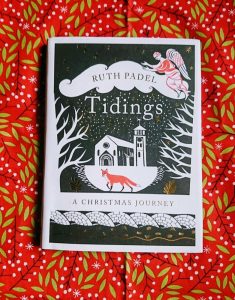Hello booklovers,
 Prize winning poet Ruth Padel (the great great granddaughter of Charles Darwin no less) certainly takes us on an emotive and thought provoking journey through London and across the world on Christmas Eve in her epic poem Tidings.
Prize winning poet Ruth Padel (the great great granddaughter of Charles Darwin no less) certainly takes us on an emotive and thought provoking journey through London and across the world on Christmas Eve in her epic poem Tidings.
We all know that Christmas Eve is an enchanted night. Father Christmas is busy doing his rounds and, as detailed by Beatrix Potter in The Tailor of Gloucester, at midnight all the animals of the world can talk to each other. Joining them in speech in this particular work is Charoum, the Angel of Silence who for this night only can speak. And with a powerful voice Charoum tells us the story of a little girl, a homeless man and a fox as we follow their experiences this Christmas Eve.
Our central characters are Holly and Robin. Holly is a little girl excited for the fun and frolics that Christmas Day will bring. Secretly she would love to have a puppy for Christmas. We first meet Holly and her mum as they hurry towards the children’s Christmas Eve service at St Pancras Church in London.
As Holly and her peers sing out to ‘The First Nowell’ we pan across to a very different scenario of a very different life. We meet ‘mad homeless Robin’ who has ‘quarreled with the world’. We find out that he has endured a childhood lacking in the love devoted to Holly, that he has not spoken to another person or touched another person for years. But he has tamed a young fox who has become his sporadic companion.
Tidings accompanies our girl, man and fox through Christmas night, and Angel Charoum takes us on a voyage to Christmases all over the globe. Our poem concludes with all the most relevant aspects of Christmas, of longing, loneliness, compassion and connection. We as readers have a duty to take these tidings into the coming year as they all culminate into the essential feeling of the lives of all – hope.
‘Let that hope shine on, like the wheel
of a rare fire rainbow in a circumhorizontal arc
above the sleeping harbour, while I fall
silent and you step back into the dark
transforming world where time, once more, is real.’